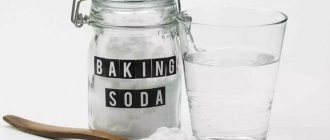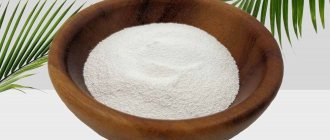The most dangerous is the contact of caustic soda with the mucous membranes of the eyes.
In the most severe cases, vision loss occurs. You need to work with this product in closed clothing. Cleaning of sewer pipes can be done in well-ventilated areas. During the procedure, it is recommended to open the window: supply and exhaust ventilation will not be effective enough. If there are no windows in the room, then you need to open the doors and additionally wear a respirator.
What is caustic soda?
Caustic soda is primarily an alkali that can corrode organic matter, while it is an excellent stain remover. Compared to baking soda and soda ash, caustic soda has a greater cleaning effect. Caustic soda is produced in the form of a powder, in which you can see small crystals and flakes, painted white. In addition, the powder does not have any odor, and the size of the grains does not exceed 1-1.5 mm.
Compound
Caustic soda consists of oxygen, sodium and hydrogen molecules, as evidenced by the structural formula of the substance NaOH. It will not be possible to find caustic soda in its pure form; it is obtained industrially from a solution of table salt. At the same time, the norm for caustic soda is considered to be no less than 98.5%. Caustic is produced both solid and in liquid form. Transported in bags or special containers.
Solid caustic, when dissolved in water, is capable of generating heat. You should use caustic with caution, as caustic soda can be harmful to health if safety rules are not followed.
Operating principle
The principle of action of caustic soda is that when it comes into contact with fatty deposits, it dissolves the fat, and if you use it when cleaning sewers, it can easily cope with organic substances that accumulate on the walls of pipes.
If caustic soda is poured into the clogged area, it will soften it, and the problem will be solved in a short period of time. After peeling off the resulting blockage and exposure to the substance, it is washed with water, pushing the blockage further along the pipe opening.
Are caustic soda and soda ash the same thing?
Caustic and soda ash are two different substances, but they are united by their alkaline origin and base. The main difference between one soda and another is its chemical composition, as well as its effectiveness. It is known that soda ash is not very effective in dealing with blockages in the sewer; when using it, there will be practically no effect. Caustic soda can deal with this problem in an instant.
Caustic soda is an alkali, and soda ash is practically the same baking soda that many people use for baking and at home.
Methods for cleaning pipes
Any problems with sewerage can be solved in two ways:
- calling a plumber;
- independent actions.
The first option is simple and straightforward, but has a significant drawback - you will have to wait for the plumber to appear, wasting your time. Sometimes this way of solving the issue turns out to be unacceptable, so they begin to solve the problem with their own hands. The available means found in the apartment are used - a plunger, a plumbing cable. First of all, you need to clean the siphons of all sinks and bathtubs, since these are where accumulations of grease, food waste and foreign objects most often form.
Chemical compounds sold in stores are often used to flush out clogs. However, often there is nothing like this in the home arsenal. There is no need to rush to the store; there is a simple and affordable way - cleaning the drain with soda and vinegar. It must be borne in mind that this option is only suitable for fatty deposits; only mechanical cleaning can remove solid particles or foreign objects.
What is caustic soda used for in everyday life?
In agriculture
In agriculture, caustic soda is used to disinfect premises where livestock are kept. At the same time, not only the territories are processed, but also all equipment.
Removing scale and deposits from dishes
Caustic does an excellent job of removing scale and deposits that form on dishes. You can do this as follows:
- To 10 liters of water, add 200 g. caustic.
- Grind 20 gr. laundry soap and add to the soda solution.
- Mix thoroughly until the ingredients are completely dissolved.
- Add 150 ml of office glue to the dishes that you plan to clean.
- Stir, put on fire and bring to a boil.
- It is recommended to boil dishes with scale and carbon deposits in this solution for 1–2 hours.
- Remove the dishes from the solution and wash with detergent.
- Rinse in running water.
This method is suitable for cookware made of enamel, cast iron and steel. It is under no circumstances recommended to clean Teflon coatings and aluminum utensils with caustic soda.
Making homemade soaps and detergents
You can use caustic soda to make homemade soap or cleaner. Recipe:
- In 150 gr. distilled water, brought to a boil, dilute 70 g. purified caustic soda.
- Flaxseed, sea buckthorn or almond oil, 0.5 kg is enough, heat in a water bath.
- Add it to the soda solution.
- To stir thoroughly.
- Pour into prepared pans.
- Keep in a dry place for several days, then remove the finished soap.
Removing blockages, cleaning drains
Some housewives clean sewers using caustic soda for a private home. This method effectively copes with any blockages.
- In a 4-liter container with cold water, add 200 g. caustic.
- To stir thoroughly.
- Pour it down the drain.
- Do not use the toilet for 1–2 hours, as the water from the flush can wash away the caustic soda and there will be no positive effect.
- After this time, rinse with 15 liters of hot water and pour it into the drain.
Cesspool cleaning
When cleaning cesspools, the proportions of substances depend directly on its size and depth.
For the procedure you will need:
- Protective gloves.
- Shovel.
- Bucket.
- Respirator.
The procedure is carried out as follows:
- 3-4 kg of caustic soda is poured into a bucket.
- Pour in 5–7 liters of water.
- Mix thoroughly.
- Pour into the cesspool.
- The procedure is carried out until the pit is completely cleared.
For disinfection
Caustic is also used for disinfection during wet cleaning.
Pumping out the pit with a suction pump
Pumping cesspools using this method does not require any intervention from the owner of the pit. It is enough to call professional vacuum cleaners and a sludge removal machine, and the cesspool will be cleared of sludge very quickly. In addition, ordering such a service also implies that the waste will not only be pumped out, but also disposed of, so you won’t have to worry about how to remove the sludge from the cesspool and take it away from the house. When calling sewer cleaners, it is worth paying some attention to the permitting documents confirming their authority.
Caustic soda in other areas
Caustic soda is used in many applications. For example, in veterinary medicine I use it to disinfect animal premises; in addition, it is used in the food, textile, pulp and paper, chemical and automotive industries. Let's take a closer look.
Use in veterinary medicine
Caustic soda is used to disinfect premises where livestock are kept. Veterinarians recommend treating these areas daily with a concentrated caustic solution. The permissible dosage of caustic soda concentration is 1%, and if animals have infectious diseases, it is increased to 10%.
Industrial Applications
In industry, caustic is used in the following industries:
- Based on it, the food additive E-524 is prepared, which is subsequently used for the preparation of chocolate products, ice cream and various drinks.
- In the production of silk products and for bleaching fabrics.
- They produce paper and cardboard.
- Manufacture of detergents.
- In the production of car batteries and fuel.
Cleaning the cesspool with chemicals
As a rule, chemicals are used in winter, since biological products cannot work in such conditions. However, chemicals are also not powerless: if the silted part of the waste is frozen, then there will be no result from their use.
Previously, formaldehyde and ammonium salts were used to clean pits, which are extremely dangerous for the environment and humans due to their toxicity. Today, it is best to clean pits with nitrate oxidizers, the negative impact of which on the soil is at a fairly low level. The principle of operation of nitrate oxidizers is in many ways similar to the work of nitrate fertilizers, therefore, after their use, the waste can be used for fertilizer. A nitrate oxidizer acts on sludge, liquefying it, removing sewer odor and reducing the volume of solid waste. In addition, chemicals work well in aggressive environments. The disadvantage of chemical cleaners is their high price.
Advantages and disadvantages
Caustic soda has both advantages and disadvantages.
Advantages:
- Quickly and effectively copes with organic contaminants.
- Has a simple application for cleaning drains.
- Completely soluble in water.
- It is not capable of harming plastic, cast iron, rubber and other materials used in sewerage parts.
- Quite a low price for the substance.
Flaws:
- Caustic soda is a substance that has a strong effect and quite high toxicity.
- Affects only organic substances.
- Has a negative effect upon contact with galvanized, aluminum and enamel coating.
- The substance should be stored only in closed form.
- Short shelf life, only 12 months.
Precautionary measures
- Caustic soda is a potent substance; in terms of its danger to humans, GOST classifies it as the second hazard class.
- The crystal powder should not be taken by hand; it should either be carefully poured out of the bag or a spoon should be used.
- Contact with skin results in burns. In this case, wash the affected area of skin with water, weakly concentrated solutions of boric or acetic acid.
- The greatest danger is if the solution gets into the eyes, resulting in loss of vision. Measures are taken immediately: the eyes are also washed, first with the above solutions, then with water.
- Therefore, it is better to protect yourself from direct contact with caustic sodium using personal protective equipment: rubber gloves, special goggles for eye protection, and overalls.
How to use soda to get rid of blockages?
Using soda to deal with clogs is quite simple, the main thing is to follow the instructions. And they do it like this:
- Pour 150 grams into the drain. caustic soda.
- Pour 2 liters of boiling water.
- Leave for 15–20 minutes.
- After this, add another 2 liters of hot water.
- Do not use the bathroom for an hour.
- Rinse the drain with 15–20 liters of water.
Cleaning with solution
To combat the blockage, it is necessary to properly prepare the solution. And you can do it like this:
- Add 2-3 kg of caustic to 8 liters of water.
- Mix thoroughly until the granules are completely dissolved.
- Slowly pour half the solution down the drain.
- After a few hours, pour out the rest.
- Flush the drain with plenty of running water.
Powder cleaning
To combat blockages using caustic soda powder, simply pour a small amount of the substance into the toilet bowl and add plenty of water. This must be done with caution, as this method can damage the sewer pipes and this can lead to leakage. Therefore, experts recommend using a small amount of the active substance and then caustic soda will do an excellent job not only with the blockage, but also corrode all the organic matter deposited on the walls of the pipes.
Gel cleaning
Clearing the blockage using a gel based on caustic soda is a less safe method, unlike the previous option. To clean, you need to mix 100 ml of gel with 250 ml of boiling water, mix thoroughly and pour into the sewer hole. Leave for several hours, then rinse with plenty of running water.
Is it possible to clean plastic pipes with caustic soda?
Cleaning plastic pipes with caustic soda is highly not recommended. It should be remembered that this substance is an alkali and may well harm the plastic product. It is better to figure out the reason why the blockage occurs periodically or use more gentle means.
Reviews
On the Internet on forums, caustic soda receives mostly positive reviews, various cleaning recipes are offered, and there are many videos about the use of the substance. One of them is offered to your attention.
https://youtu.be/u2Un0-NrFdQ
At the same time, forum members emphasize that caustic soda is not a panacea for all blockages in sewer systems. Complex, stagnant blockages can only be cleared mechanically: with a cable or by dismantling a plastic pipe, where possible, followed by cleaning.
How to flush a radiator with caustic soda?
You can only flush the radiator with caustic soda if it is made of cast iron or chrome-nickel steel. It is prohibited to use this method for radiators made of aluminum, iron, tin, zinc or lead, since when interacting with this metal, the caustic becomes an explosive substance.
Radiator flushing method:
- Flush the radiator in the summer, after turning off the heating completely.
- To do this, use a pump to pump a 15% caustic soda solution into the radiator.
- Leave the substance inside the heating device for 2–3 days.
- Drain the solution and wash with plenty of water.
Cleaning a silted septic tank
Cleaning a septic tank from sludge is not always required: many manufacturers supply their products with sludge pipes that prevent siltation of the system (read: “How to clean a septic tank with your own hands and using special means”). In the absence of such pipes, the likelihood of a blockage is quite high, and a drain pump or a sewer truck may be required to eliminate the problem.
The best means for cleaning a septic tank are the biological products described above, which break down almost all substances that enter tanks for storing and processing sewage. The only thing that bacteria contained in bioactivators cannot tolerate at all is aggressive environments. A toxic substance that gets into a septic tank will stop the life of all microorganisms inside.
This article discussed methods for cleaning various cesspools from sludge. Now that the answer to the question of how to clear a cesspool of sludge is known, you can safely use the sewer without fear of silting or overflowing.
How to fertilize garden trees with caustic soda?
Many gardeners treat garden trees with caustic soda in order to save them from diseases such as late blight, powdery mildew, black spot, and various fungi. This method differs from others in that it is quite cheap and effectively copes with the disease, increasing the abundance of the crop.
To treat trees and shrubs, you need to mix 10 liters of water and 5-6 tbsp. l. caustic, mix and water the plants. Greenhouses are also treated with this solution for disinfection before planting seedlings.
Preparation of caustic soda solution
In order to dilute soda with water, you should follow certain rules:
Preparation of the solution
the container must be resistant to alkali, for example, a thick-walled plastic bucket with a capacity of up to 12 liters is suitable; to prepare the product you need to take only cold water; You cannot pour water into the alkali, you must add soda to it, otherwise the resulting hot alkali may splash; since a large amount of heat is released during the dissolution process, the reagent must be added in small portions, with gentle stirring; a hot solution emits caustic fumes, so it is better to use a gauze mask; It is preferable to prepare the caustic solution in the open air; if this is not possible, then you should open the window to ventilate the room; For 7 liters of H2O, usually from 2 to 4 kg of soda is taken, depending on the type of residential building and sewage system.
How to clean dishes with caustic soda?
To clean the dishes, you need to do the following:
- Pour water into the contaminated container.
- For every 10 liters, you will need 200 grams. caustic.
- Add laundry soap, grated on a fine grater.
- Pour in 150 gr. office glue.
- Carefully move the solution.
- Place on fire and bring to a boil.
- Cook for 1.5-2 hours.
- Pour the solution into the sink.
- Wash dishes with detergent.
- Rinse thoroughly in running water.
This method is used for pots, pans and plates. The main thing to remember is that after the solution boils, it is recommended to keep the dishes in it for no more than 20 minutes.
Features of application
There are several universal rules when using soda:
- To carry out the procedure, it is important to remember about protective equipment: it is better to wear rubber gloves and a gauze bandage.
- Before starting the procedure, ensure good air ventilation: open a window or vent.
- Do not use baking soda on plastic pipes.
- Monitor the activity time of the soda: no more than 5-6 hours.
- Upon completion of the procedure, be sure to flush the sewer system with strong pressure of cold running water.
Safety regulations
When using caustic soda, the following safety precautions must be observed:
- Use a respirator and protective gloves.
- Store the substance in a dark place out of reach of children and animals.
- Use strictly according to the instructions, observing the proportions.
Storage requirements
It is recommended to store caustic soda in a dry and dark place in an airtight container. The lid must be tightly closed, and exposure of the substance to sunlight should be avoided. It is better to choose a storage place such that neither animals nor children can reach it.
Possible consequences
Improper storage may result in poisoning of pets, who may accidentally ingest small amounts of the substance. And if a child gets to the caustic, he may well get a burn to the skin or mucous membrane. In these cases, you should definitely seek help from a doctor. You should pay attention to the expiration date; after it expires, the caustic becomes less effective and it is better to avoid using it.
What things can be soaked in caustic soda?
You can soak white clothes in caustic soda. Since this substance is alkaline, it will do an excellent job with difficult to remove stains. It is not recommended to soak linens made of cotton and other delicate fabrics; caustic acid can damage them.
Can caustic soda be used to wash your hands?
Caustic soda can be used to wash your hands, but you must first dilute it in water and then start washing. To prepare a solution for 5 liters, 1–2 tbsp is required. l. caustic, if you put more alkali, a burn may appear on the skin. Caustic handwash is used as an antiseptic.
What to do in case of a caustic burn?
If caustic gets on the mucous membrane, it is recommended to rinse the area with 2% boric acid, and if it gets on the skin, then 5% vinegar, diluting both substances in a small amount of cold water. Only after this can you begin to treat areas with caustic burns.
Although caustic soda is a dangerous chemical, the effectiveness of its use is unlikely to leave anyone indifferent. The main thing is to follow the instructions and strictly observe the proportions, and then no problems will arise, and your dishes and drains will not need to be cleaned for a long time.
Cleaning a cesspool with a pump
To clear a silted pit, you can use a fecal or water pump connected to a reservoir for pumped out waste. The pump can be automatic (such devices are installed in a pit and work independently, pumping out wastewater as it appears) or semi-automatic (the operation of these devices must be monitored).
Before pumping begins, the siltation should be brought into a liquid state, and after pumping out the waste, it must be disposed of. When the pit is empty, it should be partially filled with water to further flush the structure. Pipelines also require cleaning, so they need to be given attention. When using a water pump, it is advisable to install a special filter to prevent clogging of the mechanisms. The fecal pump does not have this drawback and is able to work with waste immediately after installation.
Big Wash
Do you have stale cotton or linen bed linen, tablecloths and napkins in your home with old grease stains that you couldn’t wash? Surely yes. Do not rush to throw these things away or throw them away. Caustic soda will help to cope with the problem and return things to their original whiteness and freshness. There are several ways to use it.
- To soften water and remove fresh stains, add 3 teaspoons of caustic soda to the washing machine each time, along with the powder.
- When soaked, caustic soda will refresh the laundry and help remove dirt. To do this, add caustic powder along with the laundry detergent and leave for 2 hours. Don't forget to protect your hands with gloves.
- Add a tablespoon of caustic soda along with shavings of laundry soap into the basin with the laundry that is being boiled. Even the most stubborn grease stains and dirt will come off.
- For removing stubborn stains from fuel oil and machine oil from work clothes. Things are soaked for 2 hours in a solution of caustic soda - 1 tbsp. spoon per liter of water. After this they are washed in the usual way.
Gel
Cleaning drains with caustic soda is a method that is not suitable for everyone. In order not to harm your body, and not to mix the finished composition yourself, you can buy a specialized gel based on caustic soda. Instructions for use:
- Pour a small amount of gel into the drain hole (it is indicated on the label).
- Avoid using the drain for the period indicated on the gel packaging.
- After about 2 hours, wash off any remaining gel and organic waste with a strong stream of cold water.
The liquid flow should flow intensively into the drain for 15 minutes.
Instructions for preparing the solution
This method is most popular at home.
- For washing, you will need 2 kg of dry soda for treating wastewater in an apartment building or 3 kg if the house is private.
- Caustic soda is poured into a 12-liter plastic bucket. If you need auxiliary equipment, it should be made of plastic.
- Pour 4–7 liters of cold water into a container and thoroughly dilute the soda. When caustic comes into contact with water, a lot of heat is generated, the cookware can reach temperatures of up to 60 C, so you need to be careful.
- When the “boiling” reaction is complete, pour half a bucket of the resulting solution into the drain.
- Wait 2-3 hours without using plumbing during this time.
- Pour the remaining solution into the drain hole. Immediately turn on cold water to maximum and rinse for a quarter of an hour. This is necessary so that the softened dirt along with the remaining alkali is removed from the walls of the pipes.
If a “plug” has formed in an apartment building, the bucket should be poured out entirely at once, and then the cold water drain should be turned on.
We recommend: Choosing a cat litter cleaner and its proper disinfection











